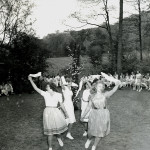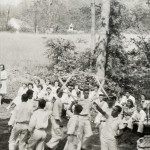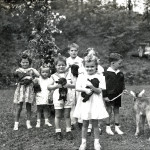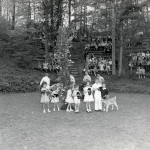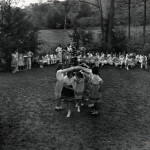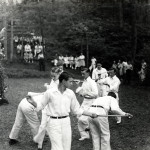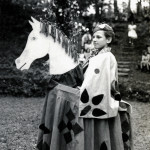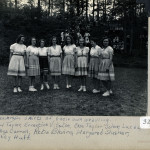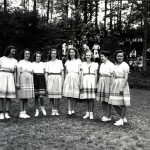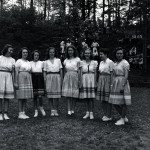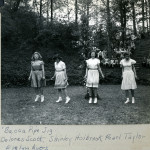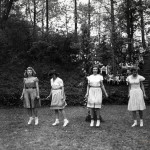Pine Mountain Settlement School
Series 16: EVENTS
EVENTS May Day
Guide
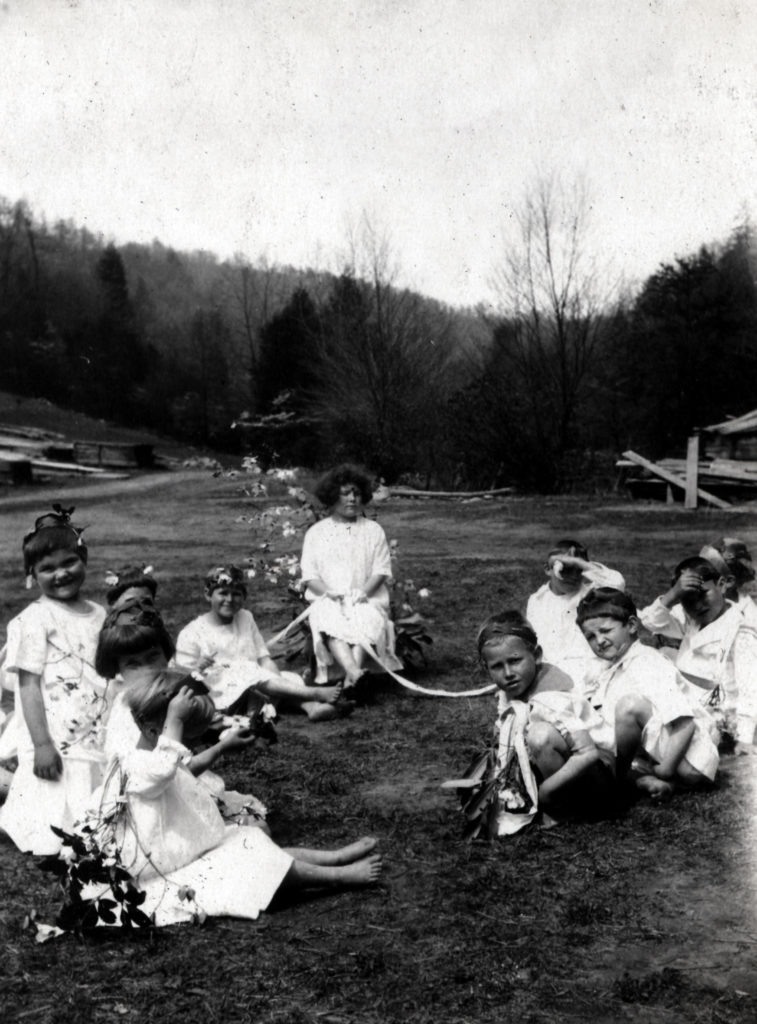
May Day at PMSS, c. 1920. [pmss0157.jpg]
TAGS: May Day, Month of May, May Pole, animals, Celtic rituals, Cecil Sharp, Dorothy Bolles, Abby Winch Christensen, Celtic May Day, English Country Dance Society, farming
EVENTS: May Day GUIDE
| MAY DAY | 1920 MAY DAY | 1930 MAY DAY | 1940 MAY DAY |
| BY YEAR | 1921 MAY DAY | 1931 MAY DAY | 1941 MAY DAY |
| 1922 MAY DAY | 1932 MAY DAY | `942 MAY DAY | |
| 1913 MAY DAY | 1923 MAY DAY | 1933 MAY DAY | 1943 MAY DAY |
| 1914 MAY DAY | 1924 MAY DAY | 1934 MAY DAY | 1944 MAY DAY |
| 1915 MAY DAY | 1925 MAY DAY | 1935 MAY DAY | 1945 MAY DAY |
| 1916 MAY DAY | 1926 MAY DAY | 1936 MAY DAY | 1946 MAY DAY |
| 1917 MAY DAY | 1927 MAY DAY | 1937 MAY DAY | 1947 MAY DAY |
| 1918 MAY DAY | 1928 MAY DAY | 1938 MAY DAY | 1948 MAY DAY |
| 1919 MAY DAY | 1929 MAY DAY | 1939 MAY DAY | 1949 MAY DAY |
Next to Christmas, May Day was one of the most festive events in the early years of Pine Mountain Settlement School. The special celebration of the first day of May was observed at the School from about 1915 until the end of the boarding school years, 1949.
May Day was particularly important in carrying forward the English Country Dance traditions that Pine Mountain adopted as part of its cultural heritage. The cultural heritage has been deeply criticized by some scholars and writers, but it was, nonetheless, a fundamental force in shaping the School in its early years. Further, it was consistent in the vision of the founders, including William Creech who found many ways to “reach across the seas” for educational opportunities and to connect with his and other Community members’ ancestors.May Day was also a time to bring ancestral and instructional points of departure for teachers, students, and families.
Typically, May Day is associated with the early pagan and largely Celtic rituals that ushered in Spring in Celtic lands. The origin of the early rituals was associated with celebrations of Flora or Floralia (the festival) of the Roman goddess of flowers. The early Celtic May Day was celebrated on April 27, and the Gaelic (Irish) celebration of Beltane (Beltaine), was celebrated on April 30.
HISTORY OF MAY DAY
While neither the Roman, nor the English, nor the Irish, nor other Northern European country celebrations follow the earliest pagan calendar or rituals, the celebration of May Day has persisted in secular culture as a time to dance, to circle a maypole and to usually crown a Queen of the May and, most importantly, to gather community together. The so-called, “Seed Time on the Cumberland,” a well-known Appalachian community celebration sponsored by Appalshop formerly in Whitesburg, Kentucky, is a May Day hold-over, but is held during June and celebrates Appalachian music more than dance. The event takes its name from Harriet Simpson Arnow’s book of the same name and is largely removed from the Celtic origins and dance seen in the early years at Pine Mountain Settlement School and other settlement institutions in the area..
The Northern European celebration has no relationship to the later adoption of May Day as celebrated by the Industrial Workers of the World, which was a celebration that appeared in the nineteenth century and was organized by Communist workers to call attention to their labor and worker’s movement, the International Workers of the World or Labour Day, as it is sometimes known.
MAY DAY AT PMSS

Pine Mountain Settlement School May Day 1939. [1939_may_day_000.jpg]
From the beginning, Pine Mountain’s celebration of May Day borrowed heavily from the traditional Celtic-English celebration of May Day by adopting many of the English Country dances, the Morris dances, the ribboned May Pole ritual, and the characteristic white dresses of the May Day participants. Many of the Pine Mountain staff were very familiar with the North Eastern May Day festivities that incorporated dances learned from the English Country Dance Society that was active on the campuses of many colleges and universities in the North East. Both Wellesley and Vassar had faculty and students who participated in English Country Dancing and followed the English Country Dance Society. Many of the staff, particularly Evelyn Wells, Dorothy Bolles, and Abby Winch “Winnie” Christensen were avid followers of the English Country Dance Society, and came as guest instructors long after they had worked at the School. Many avid fans of English Country Dance were found at Berea College, which was continues as a long associate of Pine Mountain Settlement School.
MISS BOLLES ARRIVES
In the May 1932 School newspaper, Pine Cone, the following front-page article written by the student Editor, covering the anticipated arrival of Spring and of Miss Dorothy Bolles of Boston. An avid teacher of English Country Dance, Bolles came to the School for many years to supervise the practice sessions for the May Day celebration. The article declares
Despite all weather conditions we know that spring is here when Miss Dorothy Bolles of Boston arrives to take charge of the special rehearsals of English Country Dancing leading up to their presentation by the students on May Day.
Twice during the twelve years in which Pine Mountain has been interested in English Folk Dancing the school was visited by Cecil Sharp, who was responsible for the revival of this dancing in England and America. The rustic beauty of Laurel House Dining Hall was the inspiration for its beginnings as the room offers an idea setting for Country Dancing.
The Country Dances, social in nature date back to the seventeenth century, while the Sword Dance, a favorite with the boys dates back to pre-Christian times when it was part of a religious ceremony. The Morris Dance also has its roots in antiquity, and like the Sword, is danced in England only by skilled teams of dancers.
All these forms of dancing will be presented by groups of students and workers of Pine Mountain Settlement School which is the only center of English Folk Dancing in Kentucky. *
Miss Bolles is assisted by Miss Dorothy Campbell who provides the instrumental music for the dances.
[*To follow the development of the English Country Dance program at Pine Mountain and to read more about the role of Dorothy Bolles and Dorothy Campbell, see Dorothy Bolles Correspondence Guide.]
MAY DAY AND AGRICULTURE
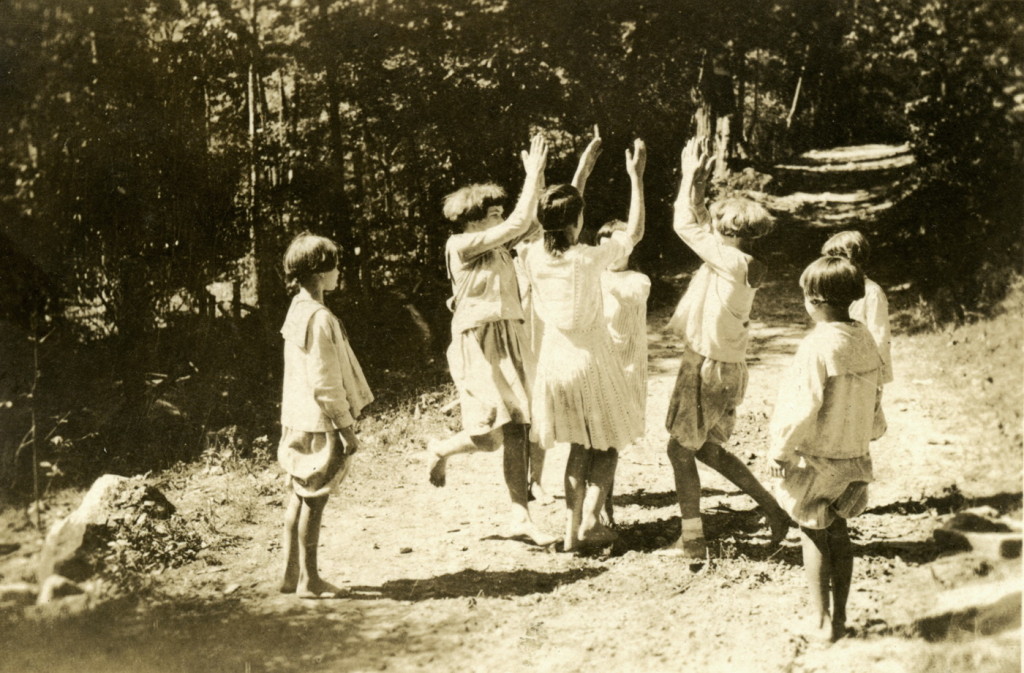
“Gathering Peascods,” c. 1920s. A favorite dance enjoyed by many of the children at Pine Mountain.[hook_067_mod.jpg
May Day is especially a time of celebration for farmers. The first planting of crops and the birthing of farm animals sometimes give the event a “Fair Day” feel. In many ways, the Spring planting and the Fall harvest are dual celebrations of the course of agriculture. By May 1, the seeds for the Fall harvest have been planted and the farmer can take time to relax until the crops called their attention. It is a time for dance.
The name of the month, “May” has its origins in the old Anglo Saxon name that, according to Bede, means “Month of Three Milkings,” in other words, a time to celebrate fecundity and to revel in nature. Bede (673-735), was a scholar and monk known for his Ecclesiastical History of the English People and also a Latin treatise called The Reckoning of Time. In this last work, Bede explains how the dates of Christian festivals should be calculated and he includes a chapter on the earlier calendar of ‘English Months.’ This calendar, used before the Roman calendar was adopted, was considered by the Church to be heathen in its ritual observances. By recording the details of the earlier calendar Bede preserved the pagan Anglo-Saxon elements for history and helped to integrate it into the Church rituals.
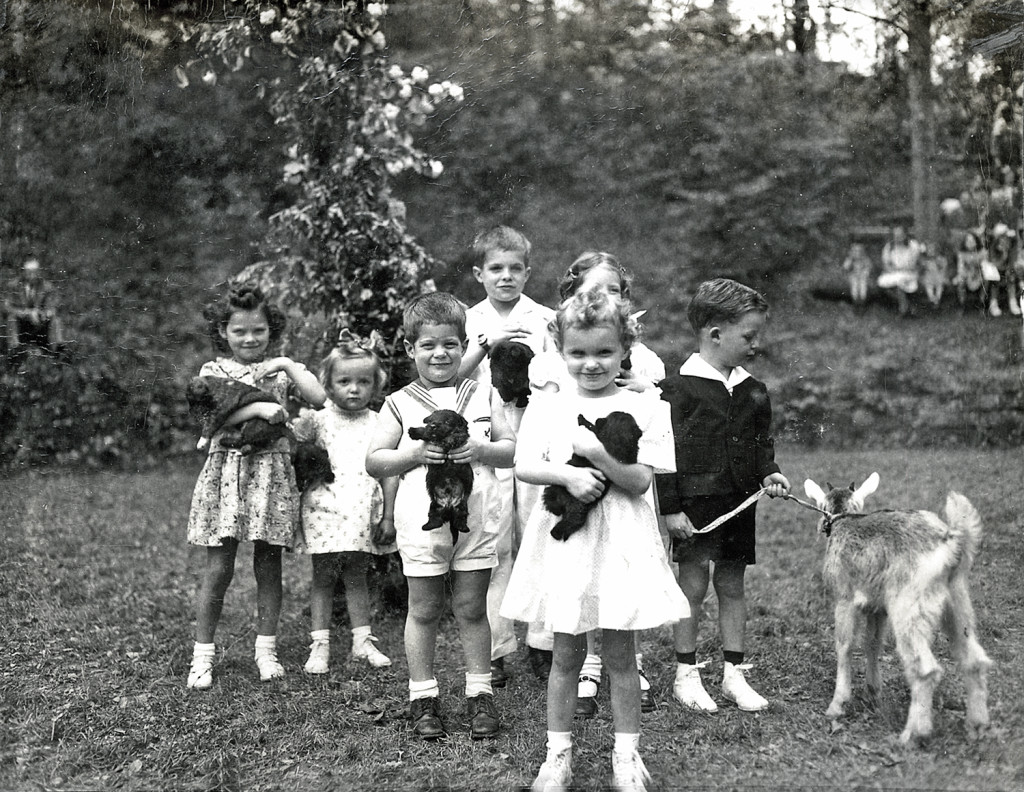
May Day celebration. c. 1945-46. From left to right with puppies and goat: ?, Helen Hayes, David Barry, Frank Barry, Kathy Barry, ? (hidden), Steven Hayes with goat, Elizabeth Dodd (front), daughter of the photographer, Arthur Dodd. The puppies are from the recent litter of the Director, Glyn Morris’ dog, Megan. [nace_1_022a.jpg]
The May Day Pole in the picture (top) above is typical of the tree-pole of the early type, which often combined flowers and ribbons that were wrapped around the pole.
Pine Mountain in its earliest years also had many skits, plays and customs that highlighted and praised the simple life of the Puritans, who gave rise to many families in the Community of Pine Mountain. Yet, it was just this religious group in England that called a halt to the May Day rituals when the Puritan parliament of the Interregnum forbade the May Day celebration. The lapse, however, was short as the custom of the May Day celebration was resumed when Charles II and Mary came to the English throne in 1660 and brought with them a more liberal set of religious values born during the difficult years of the Spanish Inquisition on the Continent.
A very early 1920 celebration of May Day at Pine Mountain is seen in the image with May Pole at the top of the page. The early Puritan prohibition did not seem to bother the staff at Pine Mountain as they could pay homage to the Puritans when Thanksgiving rolled around. The seasonal celebrations in many ways followed the non-sectarian wishes of the founders that incorporated beliefs drawn from the social, cultural and religious experiences of the broad-ranging staff at the School and the ethnic origins of the surrounding Community..
Today, it seems, the busy life, cultural changes, and other factors have taken their toll on this ancient community celebration. Recent work on the Dancing Green (fire-pit now takes center stage) and a dwindling interest in the revival of English Country Dancing at the School give mixed signals regarding the possible renewal of this traditional celebration. The new addition of a fire-pit sits within the Dancing Green circle making dancing problematic and the soil is no-longer groomed for dancing. The agrarian cycles of the School, seen in the Boarding School years, are also less compelling than in the succeeding years, when the full School both planted and harvested their food.
Yet, in recent years, as Pine Mountain Settlement returns more frequently to its agrarian roots, many of the older traditions are gaining attention and interest in both academic scholarship and in agricultural practice. The Community Fair Days and the May Day Celebration may again find their prominent place in the School’s calendar and in the community and in the regional interest in small-scale farming. What can be more pleasing than dancing in the Springtime, celebrating the birth of young livestock, planted gardens, and the joyful communion with the bountiful nature found at Pine Mountain? Dancing in the Cabbage Patch, anyone?
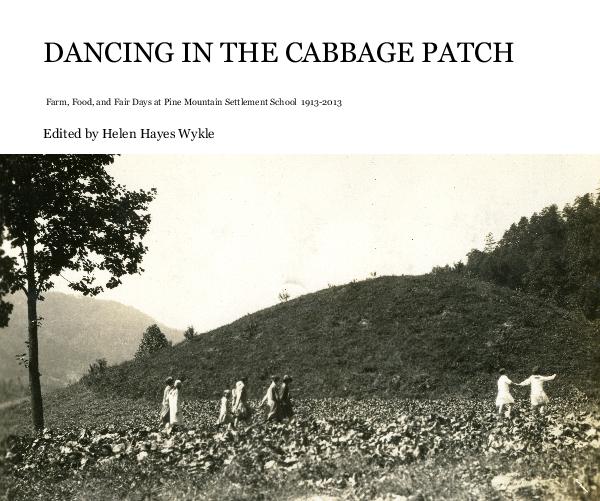
Dancing in the Cabbage Patch. [dancing-in-the-cabbage-patch-2-copy.jpg]
GALLERY: EVENTS May Day – Early Years, c. 1944 and 1945
- May Day celebration. c. 1944. [nace_1_021a]
- May Day celebration. c. 1944. Rapper swords. [nace_1_021b]
- May Day celebration. c. 1944. [nace_1_022a]
- May Day celebration. c. 1945. Staff children: (?), Helen Hayes, David Barry, Kathy Barry, Frank Barry, Steven Hayes, goat. [dodd_A_049_mod]
- May Day celebration. c. 1944. [dodd_A_052_mod]
- May Day celebration. 1945. [dodd_A_053_mod]
- May Day celebration. c. 1944. [nace_1_021c]
- Weaving class students wearing handwoven skirts, 1946. Pearl Taylor, Ernestine Vitatoe, Bess Taylor, Jolene Lucas, Gladys Carroll, Reba Blevins, Margaret Slusher, Betty Huff. [dodd_A_054.jpg]
- May Day Celebration. c. 1944. Pearl Taylor, Ernestine Vitatoe, Bess Taylor, Jolene Lucas, Gladys Carroll, Reba Blevins, Margaret Slusher, Betty Huff. [nace_1_022b.jpg]
- May Day Celebration. c. 1944. Pearl Taylor, Ernestine Vitatoe, Bess Taylor, Jolene Lucas, Gladys Carroll, Reba Blevins, Margaret Slusher, Betty Huff. May Day celebration. c. 1944. [dodd_A_054_mod]
- May Day celebration. c. 1944. [dodd_A_055]
- May Day celebration. c. 1944. [dodd_A_055_mod]
Return To:
EVENTS
EVENTS May Day Guide
EVENTS Guide to Past Events
See Also:
DANCE
DANCE Guide
DOROTHY BOLLES Staff Biography
DOROTHY BOLLES Correspondence Guide 1925-1935
ABBY WINCH CHRISTENSEN Staff Biography

